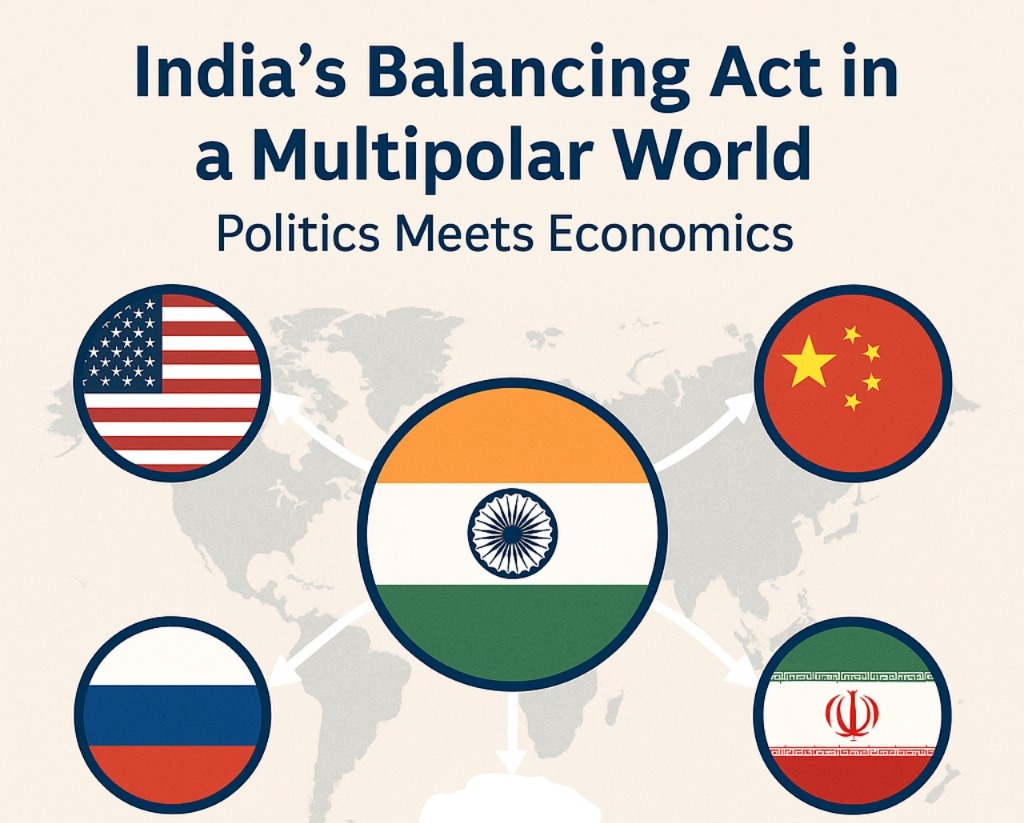India’s foreign policy has emerged as a masterclass in balancing, strategic autonomy, and economic aspiration in the constantly changing world of global geopolitics. As the globe tilts toward a multipolar reality, India is walking the tightrope carefully, managing intricate relationships with key powers such as the United States, Israel, Iran, Russia, and China. These dynamics are influenced by both economic and political considerations, frequently requiring a delicate balancing act that India must execute to safeguard its interests on the global stage.
India’s foreign policy approach—characterized by its focus on multi-alignment—has enabled the nation to court a variety of powers without compromising its independence. Yet this balancing act is becoming increasingly challenging as India’s economic and strategic interests increasingly intertwine. None of these developments is more critically highlighted than the country’s relationships with Israel, Iran, Russia, and China.
The U.S.-Israel-Iran Triangle: India’s Strategic Dilemma
India’s growing relationship with Israel, particularly in defense and technology, has further aligned the country with the United States, reinforcing its position in Western interests. India-Israel defense ties—via arms sales, collaborative technology ventures, and intelligence cooperation—have enhanced bilateral relations and further aligned India with the U.S. in counterbalancing Chinese influence in the Middle East.
However, India’s connection with Iran remains a pivotal element of its foreign policy. While Israel and the U.S. have adopted a hardline stance against Iran, especially during the Trump administration’s “maximum pressure” campaign, India cannot afford to neglect its relationship with Tehran. Iran is a critical partner for India, particularly in energy security and regional connectivity. The growth of the Chabahar Port in Iran has been central to India’s access to Central Asia and Afghanistan, offering an alternative to Pakistan’s Gwadar Port, which has been developed under Chinese support.
The recent executive order from the Trump administration, aimed at constraining India’s sanctions waiver on Chabahar, presents a major diplomatic challenge. The prospects for the development of the International North-South Transport Corridor (INSTC), linking India to Europe via Iran, are also uncertain. As tensions between the U.S. and Iran escalate, India’s
ability to maintain its alignment with both nations without antagonizing one of the parties is a central diplomatic issue.
IMEC: A Strategic Corridor in an Uncertain Landscape
The India-Middle East-Europe Economic Corridor (IMEC), inaugurated during the G20 summit in New Delhi in December 2023, is India’s vision to expand its economic footprint across the Middle East and Europe. Designed as a counter to China’s Belt and Road Initiative (BRI), the corridor aims to enhance connectivity between India, the UAE, Saudi Arabia, Jordan, Israel, and Europe. By bypassing the Suez Canal and providing a quicker, more efficient route for global trade, the IMEC has the potential to reshape regional economic dynamics.
However, the corridor’s success is far from guaranteed. The resurgence of U.S.-Iran tensions, coupled with instability in Gaza and the broader Middle East, threatens the long-term viability of the IMEC. Moreover, China’s growing economic power in Iran and the Gulf complicates India’s ambitions to establish itself as a key regional trade player. China’s strategic alignment with Iran and other Gulf states such as Saudi Arabia and the UAE threatens to undermine India’s efforts to position the IMEC as a primary trade conduit.
The Russia-India Relationship: Navigating a Shifting Dynamic
India’s relationship with Russia, while historically strong, is undergoing changes. For decades, Russia has been India’s largest defense equipment supplier, but India’s arms diversification strategy, including “Make in India,” has reduced its reliance on Russian imports. Despite this, Russia remains a key strategic partner for India, particularly as both countries contend with China’s growing influence.
The war in Ukraine has introduced additional complexity into the Russia-India partnership. While both countries continue to cooperate on defense and energy, India must balance its increasing ties with Western nations, especially in forums like the G20 and QUAD. This multi-alignment strategy, which emphasizes India’s autonomy in foreign policy, puts the country in a delicate position as it seeks to maintain its relationship with Russia without alienating the U.S. and its allies.
China’s Rising Power: An Ongoing Geopolitical Challenge
China’s growing influence remains a defining factor in India’s foreign policy. Within the BRICS bloc, China’s increasing dominance has complicated India’s strategic goals. Beijing’s deepening
ties with Russia, coupled with its expanding economic footprint in the Middle East, presents significant challenges to India’s geopolitical aspirations.
India’s efforts to counter China’s Belt and Road Initiative (BRI) through the IMEC face an uphill struggle as China strengthens its economic alliances with key Gulf nations and Iran. China’s strategic relationship with Iran, including a $400 billion infrastructure agreement, and its expansive energy relationships with GCC nations limit India’s ability to gain a strategic edge through the IMEC. As India seeks to increase its influence in the region, it must contend with China’s economic and diplomatic power, which continues to shape the Middle East’s future.
India’s Path Forward: Balancing Strategic and Economic Interests
India’s foreign policy, based on its multi-alignment approach, enables the country to maintain strong relationships with a diverse range of global powers. However, as the geopolitical landscape becomes more complex, India’s ability to balance its economic and strategic interests will be crucial. India’s success in this multipolar world order hinges on its ability to engage with the U.S., Israel, Iran, Russia, and China without compromising its core values of strategic autonomy and regional influence.
The IMEC represents a significant opportunity for India to increase its economic leverage in the Middle East and Europe, but its success will depend on India’s ability to manage competing interests, particularly in the face of rising geopolitical tensions. As India continues to navigate this intricate environment, it must ensure that its diplomatic flexibility is not constrained by regional rivalries. To remain a key player in the multipolar world, India must continue to foster strong bilateral partnerships based on mutual interests while maintaining the trust and confidence of all involved parties.
In this constantly evolving global order, India’s diplomatic acumen and strategic foresight will determine if it can successfully balance politics and economics in a multipolar world.

